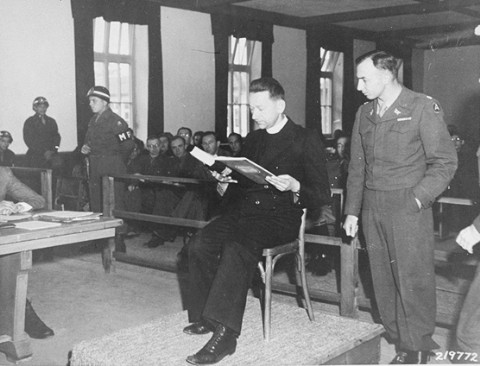Archivo:Theodore Korcz and William Dowdell Denson crop.jpg
Theodore_Korcz_and_William_Dowdell_Denson_crop.jpg (296 × 312 píxeles; tamaño de archivo: 26 kB; tipo MIME: image/jpeg)
|
|
Este es un archivo de Wikimedia Commons, un depósito de contenido libre hospedado por la Fundación Wikimedia. Más abajo se reproduce su página de descripción con la información sobre su origen y licencia. |
Resumen
William Dowdell Denson (1913-1998), U.S. Chief Prosecutor of Nazi war crimes at the concentration camp trials of Dachau, Mauthausen, Flossenbuerg and Buchenwald, held in Dachau, Germany. Born and raised in Birmingham, Alabama, Denson came from a family that had distinguished itself both in military and judicial service. After graduating from the U.S. Military Academy at West Point in 1934, Denson attended Harvard Law School, finishing in 1937. He then returned to Birmingham, where he started a private law practice. In 1942 Denson was invited back to West Point to serve as both a law instructor and the Assistant Staff Judge Advocate to the Superintendent of the U.S. Military Academy. In January 1945 Denson accepted the position of Judge Advocate General (JAG) in Europe and was assigned to Third Army headquarters in Germany. While stationed in Freising, Germany, Denson read about the liberation of Dachau in the army newspaper, Stars and Stripes. After taking part in more than 90 trials against Germans who had committed atrocities against downed American pilots, Denson was promoted to lieutenant colonel, and in August 1945 was called to serve as the Chief Prosecutor for the U.S. government at the Dachau concentration camp war crimes trial. As a result of his success in handling the trial, he was asked to serve as chief prosecutor for a series of concentration camp trials, including Mauthausen, Flossenbuerg, and Buchenwald. When these trials came to an end in early 1947, Denson returned to Birmingham, but soon moved to Washington, DC, to accept a position as co-chief legal counsel to the Atomic Energy Commission. In 1949 Denson married Countess Constance von Francken-Sierstorpff of Southampton, Long Island, with whom he had three children. In 1958 the family relocated to New York, where Denson went to work for a major law firm. Later, in 1980 he became senior litigator in a small firm in Mineola, N.Y. Denson remained in New York until his death at the age of 85.
[Sources: Denson, William. "Justice in Germany: Memories of the Chief Prosecutor." Mineola, N.Y., Meltzer, Lippe, et al. P.C., 1995; Greene, Joshua. "Justice at Dachau." New York, Broadway Books, 2003, pp.17-20; 320-356.]
The Dachau concentration camp trial opened on November 2, 1945 in Dachau, Germany. Forty individuals who had participated in the operation of the Dachau concentration camp were charged with the murder and mistreatment of foreign nationals imprisoned there. Among those charged were Martin Gottfried Weiss, the camp commandant from 1942-1943; Dr. Klaus Karl Schilling, an SS physician who was brought to Dachau to find a method of immunizing people against malaria; and three former prisoners. The trial lasted from November 15 to December 13, 1945, with seventy witnesses called for the prosecution and fifty witnesses called for the defense. All forty defendants were found guilty, with thirty-six being sentenced to death by hanging (including Weiss and Schilling), one sentenced to hard labor for life, and three sentenced to hard labor for ten years. A few of the sentences were reduced after a review board determined the defendants were involved to a lesser degree than originally believed, but most were upheld. Those sentenced to death were hanged on May 28-29, 1946 at Dachau.
Licencia
| Public domainPublic domainfalsefalse |
Esta obra se encuentra bajo el dominio público de los Estados Unidos debido a que es un trabajo hecho por un funcionario/a o empleado/a del gobierno federal de los Estados Unidos como parte de las funciones oficiales de esa persona bajo los términos del título 17, capítulo 1, sección 105 del código de los Estados Unidos. Vea Copyright.
Nota: Esto sólo se aplica a obras originales del gobierno federal y no al trabajo de cualquier persona de cualquier estado, territorio, condado, municipio, o cualquier otra subdivisión de los EE.UU. Esta plantilla tampoco se aplica a los diseños de los sellos postales publicados por el es:Servicio Postal de los Estados Unidos desde 1978. (Mira 206.02(b) of Compendium II: Copyright Office Practices). Tampoco se aplica a ciertas monedas de EE.UU., consulta los Términos de uso de la Casa de la Moneda de Estados Unidos.
|
 | |
| Esta obra ha sido identificada como libre de las restricciones conocidas en virtud del derecho de autor, incluyendo todos los derechos conexos. | ||
https://creativecommons.org/publicdomain/mark/1.0/PDMCreative Commons Public Domain Mark 1.0falsefalse
It has been requested to crop a part of this image, so that the cropped part can serve as its own image for William Dowdell Denson.
If you perform the crop, please
العربية ∙ Deutsch ∙ English ∙ Esperanto ∙ 日本語 ∙ slovenščina ∙ македонски ∙ +/− |
Leyendas
Elementos representados en este archivo
representa a
22 nov 1945
Historial del archivo
Haz clic sobre una fecha y hora para ver el archivo tal como apareció en ese momento.
| Fecha y hora | Miniatura | Dimensiones | Usuario | Comentario | |
|---|---|---|---|---|---|
| actual | 07:32 1 ago 2010 |  | 296 × 312 (26 kB) | Beyond My Ken | == {{int:filedesc}} == {{Information |Description={{en|1=Polish priest Theodore Korcz reads to Lt. Colonel William Denson from a camp medical record presented as evidence at the trial of former camp personnel and prisoners from Dachau. The log recorded |
Usos del archivo
La siguiente página usa este archivo:
Uso global del archivo
Las wikis siguientes utilizan este archivo:
- Uso en en.wikipedia.org
Metadatos
Este archivo contiene información adicional, probablemente añadida por la cámara digital o el escáner usado para crearlo o digitalizarlo.
Si el archivo ha sido modificado desde su estado original, pueden haberse perdido algunos detalles.
| _error | 0 |
|---|



